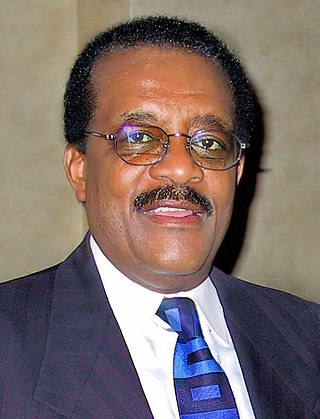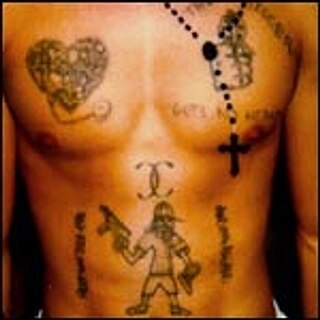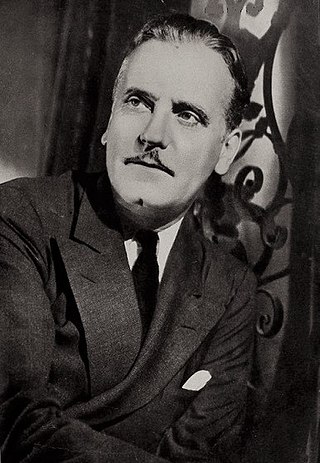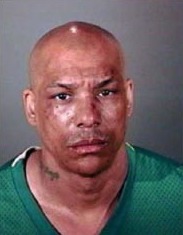
Stanley Tookie Williams III was an American gangster who co-founded and led the Crips gang in Los Angeles. He and Raymond Washington formed an alliance in 1971 that established the Crips as Los Angeles' first major African-American street gang. During the 1970s, Williams was the de facto leader of the Crips and the prominent crime boss in South Los Angeles.

Raymond Lee Washington was an American gangster, known as the founder of the Crips gang in Los Angeles. Washington formed the Crips as a minor street gang in the late 1960s in South Los Angeles, becoming a prominent local crime boss. In 1971, Washington formed an alliance with Stanley "Tookie" Williams, establishing the Crips as the first major African-American street gang in Los Angeles, and served as one of the co-leaders. In 1974, Washington was convicted of robbery and received a five-year prison sentence, during which his leadership and influence in the Crips declined.

Johnnie Lee Cochran Jr. was an American attorney best known for his leading role in the defense and criminal acquittal of O. J. Simpson for the murder of his ex-wife Nicole Brown Simpson and her friend Ron Goldman. He often defended his client with rhymes such as "If it doesn't fit, you must acquit!" during the Simpson trial.

James Alistair Taylor was an English personal assistant of Brian Epstein, the manager of the Beatles. As an employee at Epstein's company NEMS, Taylor accompanied him when he first saw the Beatles perform, at the Cavern Club in Liverpool on 9 November 1961. Taylor subsequently worked as the group's so-called "Mr. Fixit", devising escape routes from crazed fans and assisting the band members in purchasing property. He later became general manager of Apple Corps but was fired soon after Allen Klein arrived to address the company's financial problems. Taylor published various memoirs of his years in the Beatles' employ, including Yesterday: The Beatles Remembered and With the Beatles.

Redemption: The Stan Tookie Williams Story is a 2004 American biographical crime drama television film directed by Vondie Curtis-Hall, written by J.T. Allen, and starring Jamie Foxx, Lynn Whitfield, Lee Thompson Young and CCH Pounder. The film premiered at the 2004 Sundance Film Festival, and was later broadcast on the FX network on April 11, 2004.
Barbara Cottman Becnel is an American author, journalist, and film producer. She was a close friend and advocate for Crips co-founder Stanley Williams, and editor of Williams's series of children's books, which spoke out against gang violence. Williams was executed in 2005. Becnel co-produced the Golden Globe-nominated film Redemption: The Stan Tookie Williams Story, which starred award-winning actress Lynn Whitfield playing the role of Becnel.

The Crips are an alliance of street gangs that is based in the coastal regions of Southern California. Founded in Los Angeles, California, in 1969, mainly by Raymond Washington and Stanley Williams, the Crips began as an alliance between two autonomous gangs, and developed into a loosely connected network of individual "sets", often engaged in open warfare with one another. Its members have traditionally worn blue clothing since around 1973.

"Real Soon" is the first single release from Snoop Dogg's 2005 album compilation album Bigg Snoop Dogg Presents…Welcome to tha Chuuch: Da Album. It features the reunited Dogg Pound named DPGC with original first line-up that include Snoop and Nate Dogg. The song was recorded on the behalf of and to support the clemency for Stanley Tookie Williams.

George Washington Preparatory High School is a public four-year high school of Los Angeles Unified School District in Los Angeles County, California, United States. It is located in the Westmont census-designated place and has a Los Angeles postal address.

Tiequon Aundray "Lil Fee" Cox is an American street gangster and mass murderer who was sentenced to death for the August 31, 1984 murders of various family members of NFL football player Kermit Alexander. Cox is currently incarcerated in San Quentin State Prison.
The 37th NAACP Image Awards ceremony, presented by the National Association for the Advancement of Colored People (NAACP), honored the best in film, television, music of 2005 and took place on February 25, 2006, at the Shrine Auditorium. The show was televised live on Fox, March 3 at 8 p.m. EST and hosted by Cuba Gooding Jr.

Raphael Kuhner Wuppermann, known professionally as Ralph Morgan, was a Hollywood stage and film character actor, and union activist. He was a brother of actor Frank Morgan as well as the father of actress Claudia Morgan.

American Gangster is a documentary television series, which airs on BET. The show features some of black America's most infamous and powerful gangsters and is narrated by Ving Rhames. The series premiere, on November 28, 2006, amassed around one million viewers. The first season ended on January 9, 2007, and comprised 6 episodes; a season 1 DVD was released on October 23, 2007. The second season aired October 3, 2007; a season 2 DVD was released on June 10, 2008. In April 2009, A&E Networks purchased the rights to air seasons 1–3 on their networks. They can be seen primarily on the Bio Channel and the flagship A&E Channel. They can also be seen on A&E's Crime and Investigation Network.
Bastards of the Party is a 2005 American documentary film directed by former Bloods gang-member Cle Sloan and produced by Antoine Fuqua. The film explores the creation of two of Los Angeles's most notorious gangs, the Crips and the Bloods, from the perspective of the Los Angeles community. The film also denounces gang violence and presents meaningful solutions from former gang members to stop this problem.

Sanyika Shakur, also known by his former street moniker Monster or Monster Kody, was an American author and former gangster. He was a member of the Los Angeles-based Eight Tray Gangster Crips. He got his nickname as a 13-year-old gang member when he beat and stomped a robbery victim until he was disfigured. Shakur claimed to have reformed in prison, joined the Republic of New Afrika movement, and wrote a 1993 memoir called Monster: The Autobiography of an L.A. Gang Member.
Venice Shoreline Crips, or known as VSLC, is a Crips-based gang based out of Venice, Los Angeles, California.
Memphis, Tennessee serves as the Southern headquarters for Tennessee based street organizations in the Southern United States. In 2021, there were approximately 102 gangs with 13,400 gang members in the city.
The Mustache Gang is a term coined for the 1972 Oakland Athletics baseball team, a team that broke the traditionally conservative baseball views by sporting mustaches. From the change in American men's fashion away from facial hair in the 1920s to the early 1970s, there had only been two baseball players who had facial hair during the regular season: Stanley "Frenchy" Bordagaray of the Brooklyn Dodgers, who was then ordered to shave by his manager, and Wally Schang of the Philadelphia A's.

The East Side Mob Piru are a "set" of the Piru gang alliance, which is itself part of the larger Bloods alliance. Suge Knight, the co-founder and former CEO of Death Row Records, is an affiliate.
Cameron Terrell is an American former member of the Rollin 90s Neighborhood Crips gang, who was acquitted for his alleged role in the murder of 21 year-old Justin Holmes. Terrell's case received national media attention, as Terrell was white and came from an affluent background, which is unusual among members of the Crips gang.














